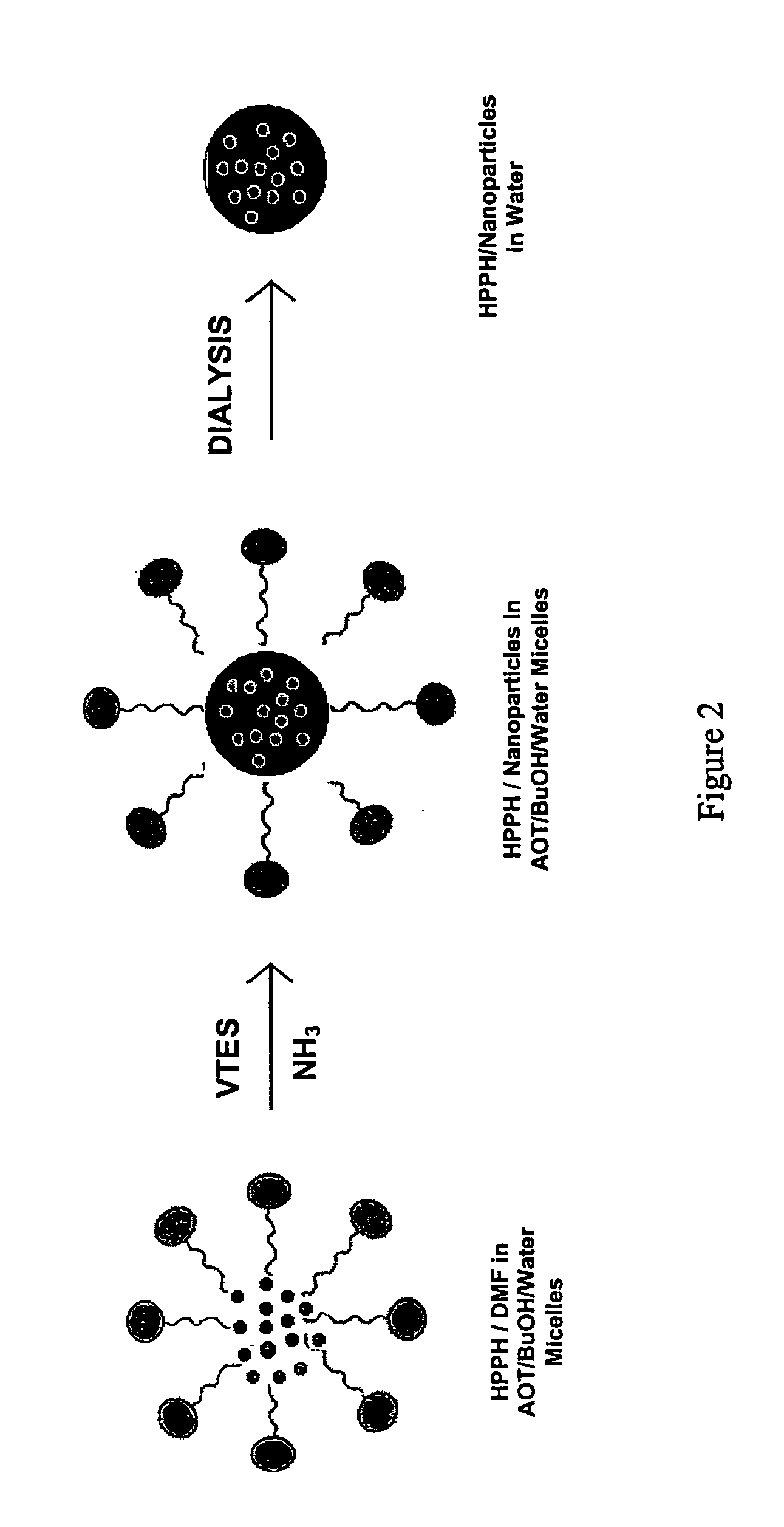Ceramic based nanoparticles for entrapping therapeutic agents for photodynamic therapy and method of using same
a nanoparticle and photodynamic therapy technology, applied in the field ofceramic based nanoparticles for entrapping therapeutic agents for photodynamic therapy and the method of using same, can solve the problems of poor drug loading, high hampered preparation of pharmaceutical formulations for parenteral administration, and increased self-aggregation of drugs in the entrapped sta
- Summary
- Abstract
- Description
- Claims
- Application Information
AI Technical Summary
Benefits of technology
Problems solved by technology
Method used
Image
Examples
example 2
[0033] This example demonstrates that the emission characteristics of the entrapped drug is the same as the unentrapped drug. To illustrate this embodiment, UV-Visible absorption Spectra of the silica particles in which the drug was entrapped and free drug was recorded on a Shimadzu (Columbia, Md.) UV-3101 PC Spectrophotometer, using 1 cm thick Quartz Cuvettes and fluorescence Spectra was recorded on a Shimadzu RF 5000U Spectrofluorimeter using 1 cm thick Quartz cuvette. The UV-Visible absorption spectra of HPPH, in AOT / BuOH / Water micelles as well as entrapped inside nanoparticles show the same peak positions for the two (FIG. 3). This demonstrates that there is no shift in peak position of HPPH upon entrapment inside nanoparticles. A control experiment, using void nanoparticles, shows virtually no absorption in the visible and Near Infra-Red (NIR) wavelength region (600-900 nm), which is the region of interest (Therapeutic Region) in PDT due to the high tissue penetration of light....
example 3
[0035] This example demonstrates the generation of singlet oxygen by the entrapped drug as detected by phosphorescence spectra. Detection of singlet oxygen (.sup.1O.sub.2) has been extensively reported by its phosphorescence emission spectra at 1270 nm [34, 35]. Since the lifetime of .sup.1O.sub.2 in water is very low (2-5 .mu.s) and hence its detection by the above method is very difficult, we have used Deuterium Oxide (D.sub.2O) owing to the enhanced lifetime (50-60 .mu.s) of .sup.1O.sub.2 in this solvent [36]. In a typical experiment, 3 mL of 22.5 .mu.M HPPH, entrapped in nanoparticles dispersed in D.sub.2O, was used. HPPH solubilized in AOT / BuOH / D.sub.2O micelles and void nanoparticles in D.sub.2O were used as positive and negative controls, respectively. A SPEX 270M Spectrometer (Jobin Yvon) equipped with In--Ga--As photodetector (Electro-Optical Systems Inc., USA) was used for recording singlet oxygen phosphorescence emission spectra. A solid-state diode-pumped laser (Verdi, C...
example 4
[0037] This example demonstrates the generation of singlet oxygen by the entrapped drug as detected by a chemical method using disodium salt of anthracenedipropionic acid (ADPA) as detector. In addition to Phosphorescence Spectra, generation of singlet oxygen was also detected chemically, using disodium salt of ADPA (9,10-anthracenedipropionic acid) as singlet oxygen sensor [36]. Disodium-ADPA (a water-soluble anthracene-derivative) is bleached to its corresponding endoperoxide on reaction with singlet oxygen, which was followed spectrophotometrically by recording the decrease in Optical Density at 400 nm (.lambda..sub.max of ADPA). In a typical experiment, 150 .mu.L of disodium-ADPA in D.sub.2O (5.5 mM) was mixed with 3 mL of 15 .mu.M HPPH (in AOT / D.sub.2O micelles as well as entrapped in nanoparticles in D.sub.2O) in 1 cm thick Quartz Cuvettes. A control experiment was carried out with disodium-ADPA mixed with void nanoparticles dispersed in D.sub.2O. The resulting solutions were ...
PUM
| Property | Measurement | Unit |
|---|---|---|
| Size | aaaaa | aaaaa |
| Diameter | aaaaa | aaaaa |
| Pharmaceutically acceptable | aaaaa | aaaaa |
Abstract
Description
Claims
Application Information
 Login to View More
Login to View More - R&D
- Intellectual Property
- Life Sciences
- Materials
- Tech Scout
- Unparalleled Data Quality
- Higher Quality Content
- 60% Fewer Hallucinations
Browse by: Latest US Patents, China's latest patents, Technical Efficacy Thesaurus, Application Domain, Technology Topic, Popular Technical Reports.
© 2025 PatSnap. All rights reserved.Legal|Privacy policy|Modern Slavery Act Transparency Statement|Sitemap|About US| Contact US: help@patsnap.com



